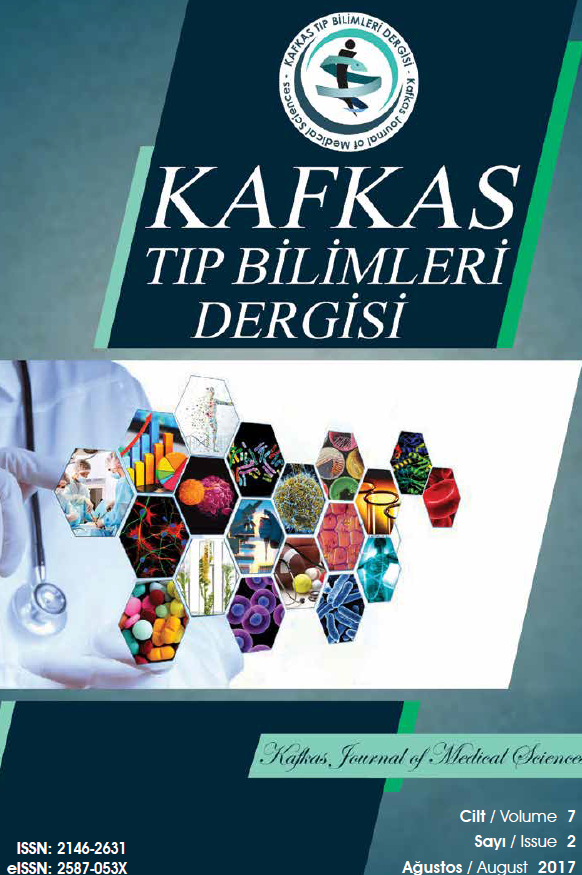En Ünlü Üç Betakoronavirüs Salgınıyla İlgili Bilimsel Verimlilik Analizi: SARS, MERS ve COVID-19
SARS, MERS, COVID-19, SARS-CoV; MERS-CoV; HCoV-EMC; SARS-CoV2
Analysis of Scientific Productivities on the Three Most Famous Outbreaks of Betacoronavirus Genus: SARS, MERS and COVID-19
SARS, MERS, COVID-19, SARS-CoV; MERS-CoV; HCoV-EMC; SARS-CoV2,
___
- 1. de Wit E, van Doremalen N, Falzarano D, Munster VJ. SARS and MERS. recent insights into emerging coronaviruses. Nat Rev Microbiol 2016;14(8):523–34.
- 2. Liu J, Zheng X, Tong Q, Li W, Wang B, Sutter K, Trilling M, Lu M, Dittmer U, Yang D. Overlapping and discrete aspects of the pathology and pathogenesis of the emerging human pathogenic coronaviruses SARS-CoV, MERS-CoV, and 2019-nCoV. J Med Virol 2020;92(5):491–494.
- 3. Song Z, Xu Y, Bao L, Zhang L, Yu P, Qu Y, Zhu H, Zhao W, Han Y, Qin C. From SARS to MERS, Thrusting Coronaviruses into the Spotlight. Viruses 2019;11(1):59.
- 4. Meo SA, Alhowikan AM, Al-Khlaiwi T, Meo IM, Halepoto DM, Iqbal M, Usmani AM, Hajjar W, Ahmed N. Novel coronavirus 2019-nCoV. prevalence, biological and clinical characteristics comparison with SARS-CoV and MERS-CoV. Eur Rev Med Pharmacol Sci 2020;24(4):2012–2019
- 5. Lai CC, Shih TP, Ko WC, Tang HJ, Hsueh PR. Severe acute respiratory syndrome coronavirus 2(SARS-CoV-2) and coronavirus disease-2019(COVID-19): The epidemic and the challenges. Int J Antimicrob Agents 2020;55(3):105924.
- 6. Xu J, Zhao S, Teng T, Abdalla AE, Zhu W, Xie L, Wang Y, Guo X. Systematic Comparison of Two Animal-to-Human Transmitted Human Coronaviruses: SARS-CoV-2 and SARSCoV. Viruses 2020;12(2):244.
- 7. Gao H, Yao H, Yang S, li L. From SARS to MERS. evidence and speculation. Frontiers of Medicine 2016;10(4):377–382.
- 8. Singhal TA Review of Coronavirus Disease-2019(COVID-19). Indian J Pediatr 2020;87:281–286.
- 9. Lee KM, Jung K. Factors Influencing the Response to Infectious Diseases: Focusing on the Case of SARS and MERS in South Korea. Int J Environ Res Public Health 2019;16(8):1432.
- 10. Reperant LA, Osterhaus ADME. AIDS, Avian flu, SARS, MERS, Ebola, Zika… what next? Vaccine 2017;35(35 Pt A):4470–4474.
- 11. Al-Tawfiq JA, Zumla A, Memish ZA. Travel implications of emerging coronaviruses: SARS and MERS-CoV. Travel Med Infect Dis 2014;12(5):422–8.
- 12. Banerjee A, Kulcsar K, Misra V, Frieman M, Mossman K. Bats and Coronaviruses. Viruses 2019;11(1):41.
- 13. Gretebeck LM, Subbarao K. Animal models for SARS and MERS coronaviruses. Curr Opin Virol 2015;13:123–9.
- 14. Fehr AR, Perlman S. Coronaviruses: an overview of their replication and pathogenesis. Methods Mol Biol 2015;1282:1–23.
- 15. Weston S, Frieman MB. COVID-19: Knowns, Unknowns, and Questions. mSphere 2020;5(2): e00203–20.
- 16. Jiang X, Rayner S, Luo MH. Does SARS-CoV-2 has a longer incubation period than SARS and MERS? J Med Virol 2020;92(5):476–478.
- 17. Coronavirus disease (COVID-19)Available at: www. who. int/ emergencies/diseases/novel-coronavirus-2019. Accessed:11 05 2021.
- 18. Yin Y, Wunderink RG. MERS, SARS and other coronaviruses as causes of pneumonia. Respirology 2018;23(2):130–137.
- 19. Brown C. MERS differs from SARS, say experts. CMAJ 2014;186(9): E303-E304.
- 20. Chiu WT, Huang JS, Ho YS. Bibliometric analysis of Severe Acute Respiratory Syndrome-related resear
- 21. Zyoud SH. Global research trends of Middle East respiratory syndrome coronavirus: a bibliometric analysis. BMC Infect Dis 2016;16:255.
- 22. Zhu C 2018 Journal impact factor list ( JCR 2018). Technical report 2018. Avalable at: https://www. researchgate. net/ publication/323571463_2018_Journal_Impact_Factor_JCR_2018.
- 23. Bas K, Dayangac M, Yaprak O, Yuzer Y, Tokat Y. International collaboration of Turkey in liver transplantation research: a bibliometric analysis. Transplant Proc 2011;43:3796–801.
- 24. Bas K, Derici S, Arkan T, Yener S, Atila K. Global Practice vs. Research on Bariatric Surgery Over the Last Decade. Clin Surg 2016;1:1201.
- 25. Haustein S, Larivière V. The Use of Bibliometrics for Assessing Research: Possibilities, Limitations and Adverse Effects. Bibliométrie évaluation de la recherche 2015:121–139.
- 26. Weingart P. Impact of bibliometrics upon the science system: Inadvertent consequences? Scientometrics 2005;62:117–131.
- 27. Thompson DF, Walker CK. A descriptive and historical review of bibliometrics with applications to medical sciences. Pharmacotherapy 2015;35(6):551–559.
- ISSN: 2146-2631
- Yayın Aralığı: Yılda 3 Sayı
- Başlangıç: 2011
- Yayıncı: Kafkas Üniversitesi
Künt Toraks Travmalarında Travma Skorlaması ile Klinik Analiz
Eray CİNAR, Kubilay INAN, Ozgur Omer YİLDİZ
Diyarbakır Yöresi 2012-2017 Yılları Arası Kanser Hastalarının Analizi
İbrahim İBİLOĞLU, Ulaş ALABALIK, Ayşe Nur KELEŞ, Gülay AYDOĞDU, Mustafa NACİR, Hatice SERTAKAN, Hüseyin BÜYÜKBAYRAM
Esra LALOĞLU, Ayşe Nur AKSOY, Alev LAZOĞLU ÖZKAYA
Kenan GUMUS, Seval KELOGLAN, Gonca USTUN, Zeliha KARAPELIT
En Ünlü Üç Betakoronavirüs Salgınıyla İlgili Bilimsel Verimlilik Analizi: SARS, MERS ve COVID-19
Toplumda Prediyabet Riski ve Tanılama Yöntemleri: Güncel Ölçüm Araçlarına İlişkin Derleme
Preterm Prematür Membran Rüptürü ile Komplike Gebeliklerde Amniyotik Membran İyileşmesi
Muhammet Serhat YILDIZ, Emre EKMEKCİ
The Rate of Anterior Commissure Invasion in Supracricoid Laryngectomy
Mehmet Akif ABAKAY, Selcuk GUNES, Ibrahim SAYİN, Burak OLGUN, Basak SAYGAN USTA, Didem CANOGLU, Mehmet SAR, Duygu YEGUL
Acil Serviste İş Kesintileri, Nedenleri, Yönetimi, Sonuçları; Pilot Çalışma
Ilker AKBAŞ, Abdullah Osman KOÇAK, Fatma Özlem ÇAYLAK, Sultan Tuna AKGÖL GÜR, Meryem Betos KOÇAK, Zeynep ÇAKIR
Ahmet Çağdaş ACARA, Sedat YANTURALI, Ömer CANACIK, Mustafa BOLATKALE
